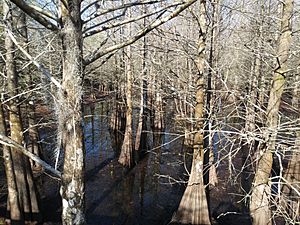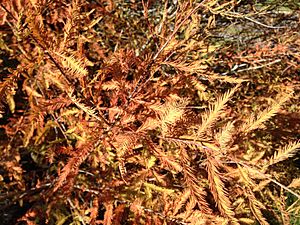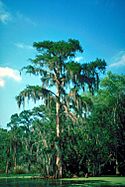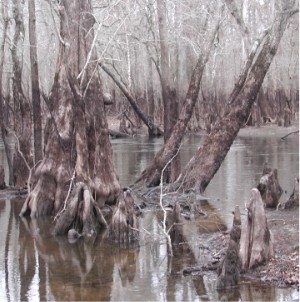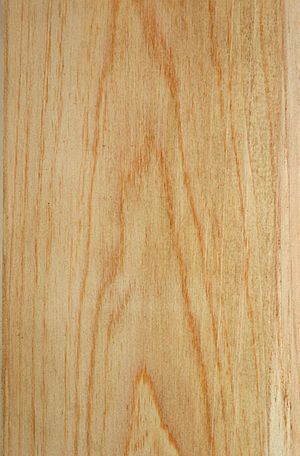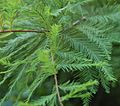Bald cypress facts for kids
Quick facts for kids Bald cypress |
|
|---|---|
 |
|
| Bald cypress forest in a central Mississippi lake | |
| Conservation status | |
| Scientific classification | |
| Genus: |
Taxodium
|
| Species: |
distichum
|
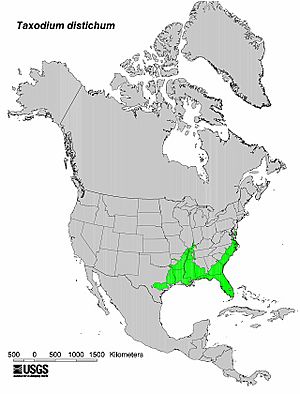 |
|
The bald cypress (Taxodium distichum) is a special type of tree. It is a conifer that loses its needles every year, just like many deciduous trees lose their leaves. This tree belongs to the Cupressaceae family. You can find it growing naturally in the southeastern United States.
Bald cypress trees are very strong and can grow in many different places. They do well in wet, salty, dry, or swampy soils. In the fall, their pretty, feathery needles turn a beautiful russet-red color before they drop off. People often plant bald cypress trees in parks and other public areas because they look nice. Some common names for this tree are swamp cypress, white cypress, and red cypress.
Contents
Discover the Bald Cypress Tree
What Does a Bald Cypress Look Like?
The bald cypress is a large tree that grows slowly and lives for a very long time. These trees usually reach heights of about 11 to 37 meters (35 to 120 feet). Their trunks can be 1 to 2 meters (3 to 6 feet) wide.
The main trunk often has strange, woody bumps around its base. These are called cypress knees. The bark of the tree is grayish-brown to reddish-brown. It is thin and feels stringy, with shallow ridges and narrow grooves.
Bald Cypress Leaves and Cones
The leaves are like small needles, about 1 to 2 centimeters (1/2 to 3/4 inch) long. They are simple, green, and grow in an alternating pattern along the branches. In autumn, these needles change to yellow or copper red. Then, the bald cypress drops its needles in winter and grows new ones in spring.
This tree has both male and female parts on the same plant. This is called being monoecious. The flowers grow on slender, tassel-like structures. The tree flowers in April, and its seeds are ready in October. Male cones are about 10 to 13 centimeters (4 to 5 inches) long. Female cones are round and green when they are young. They become hard and brown as they get older. Each cone is about 2 to 3.5 centimeters (0.8 to 1.4 inches) wide. They hold 20 to 40 large seeds. The cones break apart when they are ready to release the seeds.
Where Bald Cypress Trees Grow Best
Bald cypress trees can grow in full sunlight or partial shade. They grow best in wet or well-drained soil, but they can also handle dry soil. They can even grow in salty soil and are somewhat tolerant of salt spray from the air. These trees do well in acidic, neutral, or alkaline soils. They can also handle air pollution. Many animals eat the seeds from the cones.
Record-Breaking Bald Cypress Trees
The tallest known bald cypress tree is near Williamsburg, Virginia. It stands 44.11 meters (145 feet) tall. The widest known tree is in Real County, Texas, near Leaky, Texas. Its trunk is 475 inches (39 feet) across!
The National Champion Bald Cypress is the largest of its kind in the United States. It is located in the Cat Island National Wildlife Refuge in St. Francisville, Louisiana. This amazing tree is 29 meters (96 feet) tall and 17 meters (56 feet) around. Experts believe it is about 1,500 years old. The oldest known living bald cypress is along the Black River in North Carolina. It is at least 2,624 years old, making it the oldest living tree in eastern North America.
Bald Cypress Family and Relatives
Some scientists think the Taxodium ascendens (pond cypress) is a different species. Others believe it is just a type of bald cypress. The pond cypress has shorter leaves and grows in specific low-nutrient water areas. Some also consider the Taxodium mucronatum to be a type of bald cypress. This means some experts think there might only be one main species in the Taxodium group.
Where Bald Cypress Trees Live
Bald Cypress Natural Range
The bald cypress naturally grows from southeastern New Jersey down to Florida. Its range also stretches west to East Texas and southeastern Oklahoma. It grows inland along the Mississippi River. Long ago, huge bald cypress forests, with trees over 1,700 years old, covered the swamps of the Southeast.
Scientists recently found a natural forest in southern New Jersey. This means the tree's natural range extends further north than once thought. The largest old-growth forests still standing are at Corkscrew Swamp Sanctuary in Naples, Florida. Another big forest is along eastern North Carolina's Black River. The trees at Corkscrew are about 500 years old. Some are taller than 40 meters (130 feet).
A scientist named David Stahle studied the Black River trees. He found that some started growing as early as 364 AD!

This tree loves humid places. It gets about 760 millimeters (30 inches) of rain in Texas and up to 1,630 millimeters (64 inches) along the Gulf Coast each year. Even though it grows best in warm weather, it can handle cold. However, very cold temperatures can stop new seedlings from growing. Older trees can survive much colder weather and less humidity.
Ancient Underwater Forests
In 2012, scuba divers found an amazing underwater cypress forest. It was several miles off the coast of Mobile, Alabama, about 18 meters (60 feet) deep. The trees in this forest are more than 50,000 years old! This means they lived during the early part of the last ice age.
The forest is very well preserved. When pieces of the wood are cut, they still smell like fresh cypress. Scientists are studying this special site. One idea is that Hurricane Katrina uncovered this ancient grove. It had been protected under the ocean floor for thousands of years.
Bald Cypress Life Cycle and Reproduction
The bald cypress is a monoecious tree, meaning it has both male and female parts. Male and female cones grow from buds that formed the year before. Male catkins are about 2 millimeters (0.08 inches) wide. They hang in purplish clusters 7 to 13 centimeters (2.8 to 5.1 inches) long. These are easy to see in winter. Pollen is released in March and April.
Female cones are found alone or in small groups. They change from green to brownish-purple as they ripen from October to December. The cones are 13 to 36 millimeters (0.5 to 1.4 inches) wide. They have 9 to 15 scales that break off when ripe. Each scale can hold two or sometimes three seeds. Each cone has about 16 seeds, but can have up to 34.
How Bald Cypress Seeds Spread
The seeds can only survive for less than one year. They spread in two main ways. First, by water: the seeds float and move with floods until the water goes down or the cone lands on shore. Second, by animals: squirrels eat the seeds. But they often drop parts of the cones with good seeds still attached. Floods are the most important way for seeds to spread along rivers.
New Growth from Stumps
Bald cypress is one of the few conifer trees that can sprout new growth from a stump. Young trees can produce strong sprouts if cut in fall or winter. Even trees up to 60 years old can sprout. However, these sprouts often do not survive well or grow into good timber trees. Stumps of trees up to 200 years old can also sprout, but these are weaker.
Bald Cypress in Nature
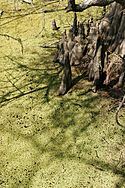
Seeds do not grow underwater. They rarely grow on very dry soil. Seedlings usually start on soil that is always wet, but not flooded, for one to three months. After growing, seedlings must grow quickly to avoid floodwaters. They often reach 20 to 75 centimeters (8 to 30 inches) tall in their first year. Seedlings will die if they are underwater for more than two to four weeks. So, new trees cannot grow naturally in places that are always flooded.
Most bald cypress trees do not produce seeds until they are about 30 years old. In good conditions, young bald cypress trees grow quite fast. They slow down as they get older. Some trees have grown 3 meters (10 feet) in five years. They can reach 21 meters (69 feet) in 41 years and 36 meters (118 feet) in 96 years. Height growth mostly stops when the trees are 200 years old. Some trees can live for over 1,000 years!
Bald cypress trees that grow in swamps have special growths called cypress knees. These are woody parts of the root system that stick out above the ground or water. People once thought they helped the roots get oxygen. But studies show this is not true. A more likely reason is that they help support and stabilize the tree.
Trees growing in flood-prone areas often have wide, strong bases. This helps them stand firm. Their strong, tangled root system helps them resist very strong winds. Even hurricanes rarely knock them over.
Threats to Bald Cypress Trees
Several things can harm bald cypress trees. The main problem is a fungus called Lauriliella taxodii. This fungus causes a brown rot in the heartwood of living trees. It is known as "pecky cypress." It usually attacks from the top of the tree down to the roots. Other fungi and insects can also damage the trees. For example, the cypress flea beetle and the bald cypress leafroller can harm leaves, cones, or bark. Nutrias are animals that can also damage young bald cypress seedlings. They sometimes destroy a whole group of young trees.
Protecting the Bald Cypress
In 2002, the state of Indiana listed the bald cypress as a threatened plant. This means it needs protection there. However, around the world, the IUCN says the species is of Least Concern. This means it is not currently at high risk of disappearing globally.
How People Use Bald Cypress Trees
The bald cypress is a very strong tree. It can be planted in many different climates. It is a popular ornamental tree because of its light, feathery leaves and pretty fall colors. When planted by people, it can grow well in many types of soil. This includes dry places where it might not grow naturally. It can even grow far north of its native home, like in southern Canada. People also plant it in Europe, Asia, and other temperate and subtropical areas. However, it needs hot summers to grow well. In places with cool summers, it grows very slowly.
Bald cypress wood is very valuable. In old forests, there was a lot of wood per area. The wood is good for building, fence posts, boat parts, doors, and floors. It is also used for shingles, garden boxes, and cabinets. The wood does not have a smell. It has been valued for a long time because it resists water damage.
Timber Framing and Prehistoric Wood
Bald cypress wood is often used for outdoor structures. These include timber frame pavilions, farmers markets, porches, and decorative trusses. Its ability to resist weather helps these structures last a long time.
Sometimes, very old wood is found in swamps. This wood is from trees that lived thousands of years ago. It is partly mineralized but still usable. This "prehistoric wood" is highly valued for special uses like carvings. The fungus that causes "pecky cypress" wood makes it good for decorative wall panels.
The bald cypress was named the official state tree of Louisiana in 1963. Many people see it as a symbol of the southern swamps in the United States.
Native Americans used bald cypress trees for many things. They made coffins, homes, drums, and canoes from the wood. An early settler in Kerrville, Texas, named Joshua D. Brown, made a living by making shingles from bald cypress trees. These trees grew along the Guadalupe River. In the early 1990s, bald cypress was heavily harvested for paneling, mulch, and shingles.
Images for kids
See also
 In Spanish: Ciprés de los pantanos para niños
In Spanish: Ciprés de los pantanos para niños



